Understanding PTO Manure Spreaders for Modern Farming
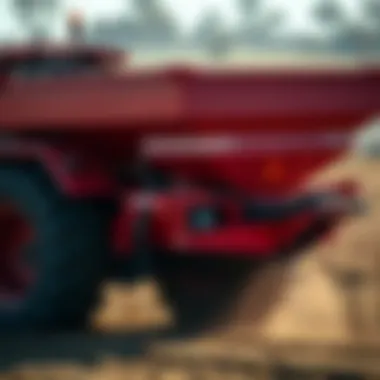
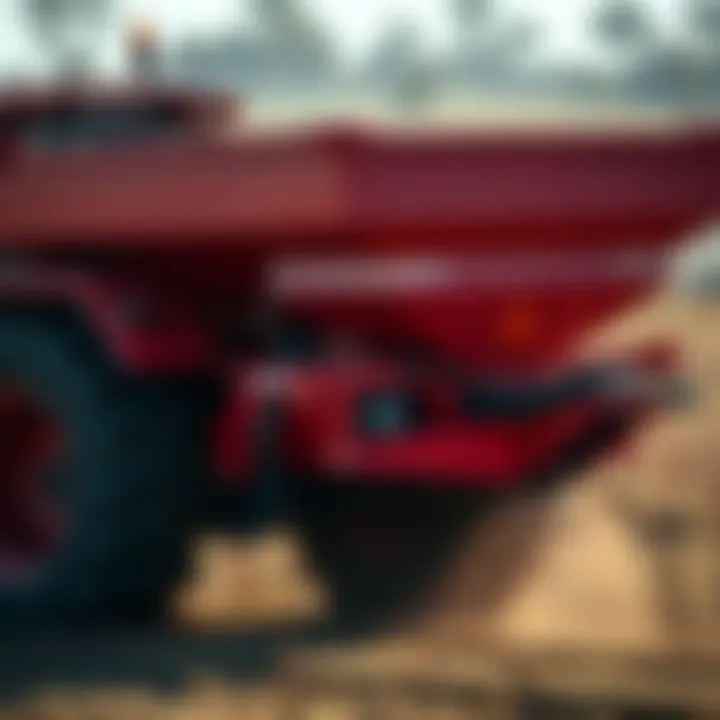
Topic Overview
Definition and Importance
PTO manure spreaders are vital tools in modern agriculture, designed specifically for spreading livestock manure uniformly across fields. The acronym "PTO" stands for Power Take-Off, highlighting how these machines draw power from tractors to function effectively. Their importance lies in their role in sustainable farming; returning nutrients to the soil is essential for maintaining soil health, improving crop yields, and promoting eco-friendly farming practices. Manure, rich in nitrogen, phosphorous, and potassium, acts not just as a fertilizer but as a natural means to feed crops, thus reducing reliance on synthetic fertilizers.
Brief History and Evolution
The journey of manure spreaders is quite fascinating. In the late 19th century, farmers relied on manual methods using carts to distribute manure, which was labor-intensive and inefficient. By the early 20th century, the advent of mechanized agriculture brought changes. PTO manure spreaders began appearing on farms, enabling quicker and more uniform application of manure. Over the decades, these machines have seen significant advancements, with later models incorporating features such as adjustable spread widths and enhanced capacity for improved performance.
As farming technology progressed, today's PTO manure spreaders now come equipped with various innovations like GPS technology and load sensors that help optimize the spreading process, ensuring efficiency and precision. This evolution marks an ongoing commitment to improving agricultural practices, aiming to meet the rising demands of global food production while respecting the environment.
Key Techniques and Innovations
Sustainable Farming Practices
Sustainable agriculture prioritizes environmental health, economic profitability, and social equity. Using PTO manure spreaders fits snugly into this framework. By incorporating manure management into farming practices, farmers can reduce chemical runoff and improve overall soil quality. For instance, cover cropping paired with manure spreading enhances soil structure and fertility, making a powerful case for using organic nutrients instead of chemical fertilizers.
Moreover, best practices involve careful timing of spreading—which not only maximizes nutrient uptake by crops but also minimizes loss to the atmosphere. Investing in precision application techniques ensures that manure is spread in optimal conditions, thus enhancing sustainability in farming operations.
Advanced Agronomic Technologies
In an era where technology shapes farming, PTO manure spreaders are no exception. Advanced technologies such as variable rate application and automation are increasingly becoming the norm. For example, using sensor technology, farmers can adjust the amount of manure spread based on real-time soil nutrient readings.
This integration of technology means that not only can farmers optimize their costs, but they can also significantly lower their environmental footprint. When utilized correctly, these innovations foster a more precise approach to farming that balances productivity with sustainability.
Practical Applications
Step-by-Step Guides
- Choosing the Right PTO Manure Spreader: Understand the size and type required for your farm's needs. Options include horizontal or vertical spreaders, each suited for different applications.
- Maintaining Your Spreader: Regular inspections and maintenance are crucial. Check the gearbox oil, grease the bearings regularly, and inspect all moving parts for wear and tear.
- Timing the Application: Apply manure when soil moisture is ideal and crops are actively growing to maximize nutrient uptake. Early spring or late fall can be ideal conditions depending on local climate.
Case Studies or Real-World Examples
To illustrate the benefits of PTO manure spreaders further, consider the example of a farm in the Midwest that adopted these machines five years ago. Transitioning from conventional spreading methods, they reported a yield increase of approximately 15% in their corn crops. By implementing precise spreading techniques, they also noted a reduction in fertilizer costs and a more balanced nutrient profile in their soils.
Such real-world cases highlight the practical efficacy of PTO manure spreaders, showcasing how farmers can achieve both higher productivity and environmental responsibility.
For more detailed information on sustainable farming and manure management, check out resources like Wikipedia's article on Sustainable Agriculture or the USDA Sustainable Agriculture Research.
Additionally, forums like Reddit’s Farming community often provide insights from seasoned farmers on their experiences with PTO spreaders.
Preface to PTO Manure Spreaders
PTO manure spreaders play a critical role in modern agricultural practices, transforming the way farmers handle organic waste. These machines allow for efficient distribution of manure across fields, creating a multitude of benefits for soil health and crop production. Understanding the ins and outs of PTO manure spreaders can be pivotal for both novice and experienced farmers; they are not just tools, but vital components in sustainable farming.
Definition and Purpose
A PTO manure spreader is a machine that is designed to distribute manure using a Power Take-Off (PTO) mechanism from a tractor. Essentially, the PTO transfers power from the tractor’s engine to the spreader, enabling it to operate efficiently. The primary purpose of these spreaders is to apply manure evenly across farmland, which enriches the soil with essential nutrients. This operation not only aids in waste management, but also promotes better crop yields and healthier soil ecosystems. Farmers can opt for various types of PTO manure spreaders, tailoring their choices based on specific needs and farm layouts.
Importance in Agricultural Practices
In the realm of agriculture, the significance of PTO manure spreaders cannot be overstated. Here are a few key points illustrating their importance:
- Nutrient Management: Manure is often a rich source of nitrogen, phosphorus, and potassium. Proper application through a PTO manure spreader ensures that these vital nutrients are distributed evenly, thus promoting robust plant growth.
- Resource Efficiency: Farmers using these spreaders can significantly cut down on labor costs and time spent on manure management. By streamlining the application process, it allows for more efficient farming practices overall.
- Sustainable Practices: In an age where sustainability is a focal point in agriculture, using PTO spreaders aligns well with environmentally friendly practices. It ensures that waste is not just discarded, but utilized to foster soil health and agricultural productivity.
- Improved Soil Structure: Applying manure with precision helps maintain the balance of organic matter in the soil, enhancing its structure and water retention capabilities.
"A well-maintained soil is the foundation of successful farming. The efficiency of PTO manure spreaders provides farmers with the tools to maintain that foundation."
Understanding PTO (Power Take-Off)
In the realm of modern agriculture, understanding PTO, or Power Take-Off, is crucial for anyone dealing with PTO manure spreaders. This component serves as the backbone of connecting various implements to a tractor, enabling efficient operations in the field. Without a solid grasp on how PTO mechanisms function and the different types available, it's challenging to maximize your farming equipment’s potential.
Mechanism of Power Transmission
At its core, the PTO mechanism works by transferring the tractor’s engine power to attached implements. It operates using a rotating shaft that taps into the tractor's power, converting it into mechanical energy. The power can be harnessed in various forms, allowing the lift and movement of manure spreaders, amongst other devices. This simple yet effective design is often overlooked, yet it lies at the heart of effective agricultural practices.
The torque generated provides significant benefits: it allows for a steady flow of power, which in turn leads to enhanced efficiency in the spreading process. Without this constant power source, the function of spreaders would be unreliable, resulting in uneven distribution and potential nutrient loss.
Types of PTO Systems
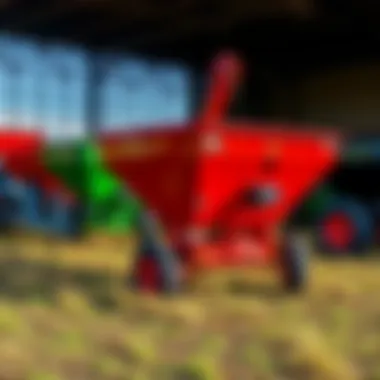
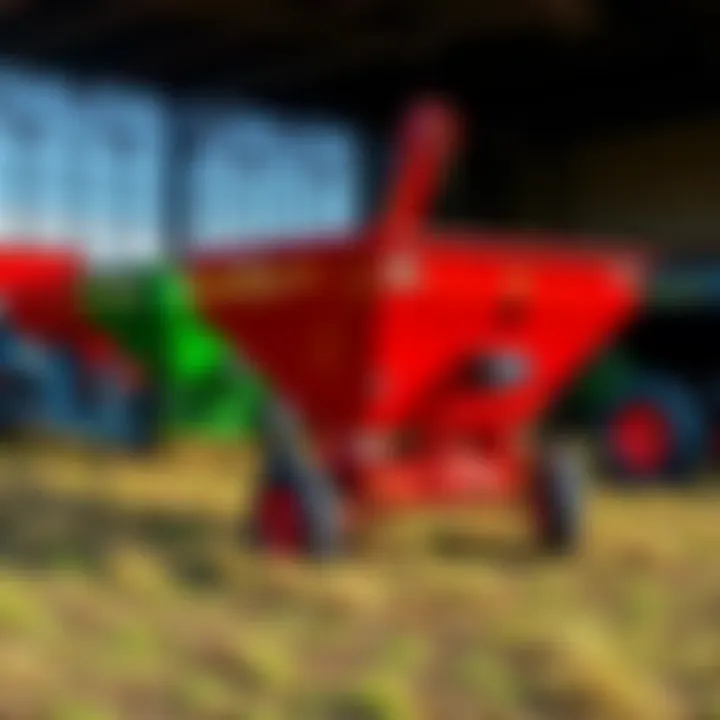
Understanding the types of PTO systems helps farmers choose the right configuration for their equipment, ensuring they utilize their spreaders to the fullest.
Standard PTO
The Standard PTO is perhaps the most commonly utilized system in agriculture. This setup features a two-spline connection and facilitates straightforward attachment of implements. Its key characteristic is its simplicity, enabling farmers to connect and disconnect equipment with minimal effort.
This system’s efficiency often lies in its availability and reliability—two significant attributes for any farming operation. The major advantage is its ease of use; however, it can have limitations in power output compared to newer systems.
Compact PTO
Moving towards more specialized applications, Compact PTO systems cater to smaller tractors. One standout feature is their ability to fit into tighter configurations, making them popular among farmers with limited space or smaller equipment.
Their compact nature provides a considerable advantage when dealing with smaller-scale operations where space and maneuverability are key factors. However, potential drawbacks include reduced power capabilities compared to standard systems.
Independent PTO
Finally, the Independent PTO system provides a unique approach by allowing implements to operate independently of the tractor's movement. A crucial feature of this system is its flexibility; farmers can control the power delivery even when the tractor isn't moving.
For applications that require consistent speed and an uninterrupted flow of power, this feature proves invaluable. While offering considerable advantages in specific scenarios, it requires careful handling to avoid complications during operation.
Understanding these PTO systems is vital, as it helps identify the best options for different types of manure spreaders. Each system has unique characteristics, which can influence the efficiency and success of manure application on farms.
"The right PTO choice can make all the difference in efficiently spreading nutrients across your fields."
For more information on Power Take-Off systems, you can explore resources provided by experts in agricultural practices at Wikipedia and Britannica.
By knowing the nuances of PTO systems, a farmer is better positioned to optimize their manure spreading practices and enhance overall farm management.
Varieties of PTO Manure Spreaders
The variety of PTO manure spreaders in the market today showcases the evolution in agricultural practices, reflecting demands for efficiency and sustainability in farming. Understanding these various types is essential for farmers aiming to maximize productivity while minimizing environmental impact. Each model brings unique advantages, suitable for different types of manure and applications. The choice of a manure spreader can profoundly affect not just crop yields but also the overall health of the soil and the surrounding environment.
Rotary Spreaders
Rotary spreaders are renowned for their ability to evenly distribute manure across vast areas. Their operation is straightforward; manure is flung from a central rotating disk, allowing for a wide dispersal pattern. This method is perfect for farmers dealing with large fields, as it covers more ground in less time.
One of the biggest draws of rotary spreaders is their capacity to handle both liquid and solid manure. Farmers appreciate that they can adjust the spread width, making it easier to apply the right amount of nutrients exactly where needed. However, it’s important to understand that rotary spreaders may require careful calibration to prevent over-application, which can lead to nutrient runoff or soil degradation.
Chain Floor Spreaders
Chain floor spreaders use a belt with chains to move manure towards the rear and then discharge it in a controlled manner. This kind of spreader is particularly effective with heavier types of manure, including those with higher solids content.
The significant benefit of chain floor spreaders is their capacity for slow, steady application rates, which means less nutrient loss. They operate quietly, and many models offer flexibility in terms of discharge options, whether spreading directly onto the field or in designated areas. On the flip side, their maintenance can be more involved, requiring regular inspection of the chain and floor mechanisms to ensure smooth operation.
Broadcast Spreaders
Next, we have broadcast spreaders, which excel at spreading manure over a wide area quickly and uniformly. Utilizing a powerful distribution system, they fling manure outward, making them a popular choice for pasture upkeep or larger crop fields requiring uniform nutrient distribution.
Farmers often favor these for their ability to work with different types of organic fertilizers as well, not just manure. However, one must be cautious during windy conditions since this can lead to uneven spreading and potential waste of resources. The calibration and maintenance of broadcast spreaders are vital, ensuring that the application aligns with the agronomic needs of the crops.
Vertical Tillage Spreaders
Lastly, vertical tillage spreaders are somewhat of a hybrid, using a combination of vertical tillage and manure spreading techniques. They not only spread manure evenly but also incorporate it into the soil in a single pass. This is especially beneficial for promoting soil health and enhancing nutrient absorption directly into the root zone.
The significant advantage lies in their ability to break up soil compaction while applying manure, promoting better seedbed preparation and creating an optimal environment for plant growth. These spreaders can be complex and pricier, but for many farmers, the long-term benefits of improved soil structure and crop yield are worth the investment.
"The right manure spreader can transform your agricultural experience, enhancing both efficiency and soil health."
Choosing wisely can pave the way for fruitful harvests and robust soil ecosystems.
Benefits of Using PTO Manure Spreaders
PTO manure spreaders are vital in modern agriculture, merging efficiency with sustainability. Their utilization brings forth multiple benefits, enabling farmers to enhance productivity while nurturing the health of their land. Below, we explore key aspects of these advantages, specifically focusing on efficiency, nutrient management, and soil health improvement.
Efficiency in Spreading Manure
Time is money in agriculture, and PTO manure spreaders excel in helping farmers make the most of both. These machines are designed to work rapidly yet effectively, allowing for even manure distribution across fields. Such precision helps avoid over or under-application, which could lead to crop stress or nutrient waste.
- Speed: A PTO manure spreader can cover large areas in a fraction of the time compared to manual methods, ensuring that the job is done efficiently during busy seasons.
- Consistency: The machinery ensures uniform spreading, minimizing the chances of clogging or uneven distribution that might occur with lesser technologies.
- Labor Reduction: The automation of manure spreading alleviates the physical load on farmers and their workers, allowing them to focus on other pressing tasks on the farm.
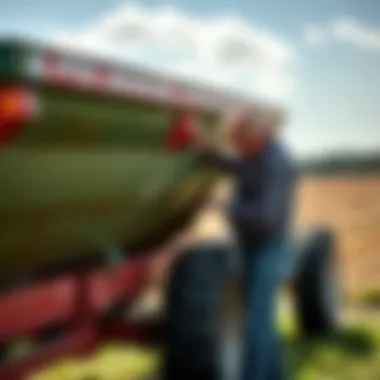
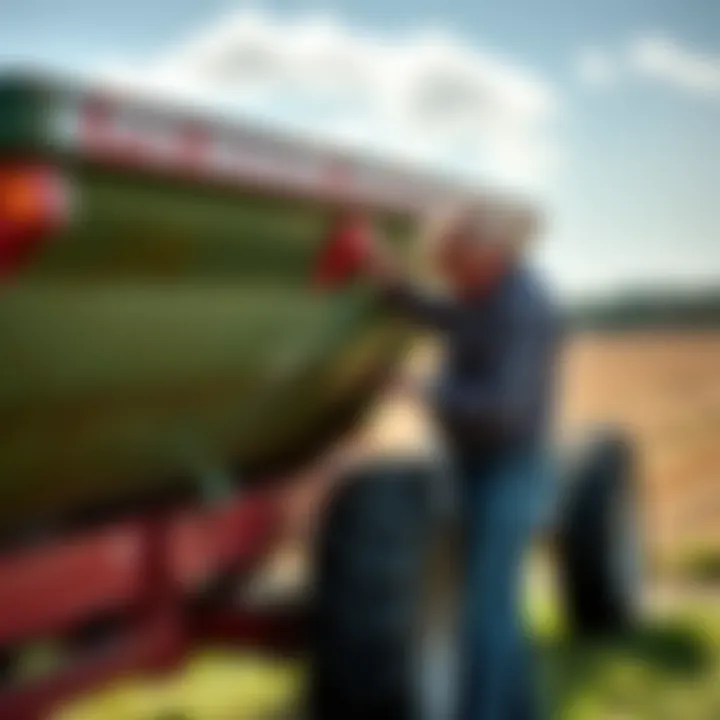
Thus, the efficiency of PTO manure spreaders translates directly into productivity and economic viability for any farming operation.
Enhanced Nutrient Management
Proper nutrient management is crucial for sustainable farming, and here is where PTO manure spreaders shine. They guarantee that manure is applied in a manner that maximizes nutrient retention within the soil, thereby contributing to healthier crops.
- Targeted Application: Adjusting the spreader settings permits precise application rates based on soil needs, crop type, and growth stage.
- Reduced Nutrient Loss: By evenly distributing manure, farmers can mitigate the risk of nutrient runoff during rain, preserving vital minerals in the soil.
- Increased Yield Potential: Consistent manure application ensures crops receive their nutrient requirements, positively impacting yield and profitability.
PTO manure spreaders help strike a balance between applying sufficient nutrients and avoiding excessive input, thus supporting environmental health alongside agricultural profitability.
Soil Health Improvement
Soil is the backbone of agriculture, and enhancing its health is paramount for successful farming. PTO manure spreaders contribute to this goal in several ways.
- Microbial Activity: The organic matter in manure promotes beneficial microbial populations in the soil, aiding in breakdown of nutrients and improving soil structure.
- Nutrient Cycling: Regular application of manure through PTO spreaders sustains a cycle of nutrients, significantly boosting soil fertility over time.
- Erosion Control: The strategic use of manure as a soil amendment helps in reducing erosion since it improves soil aggregates and stability.
"Healthy soil leads to healthy crops." By investing in a PTO manure spreader, farmers are not only fostering their immediate agricultural needs but also working towards the long-term sustainability of their land.
In summary, the benefits offered by PTO manure spreaders are profound. Increased efficiency in manure application, strengthened nutrient management practices, and significant improvements to soil health set these machines apart in the realm of agriculture. To fully reap these rewards, harnessing the full potential of PTO manure spreaders aligns with current innovative and sustainable agricultural practices.
Optimal Use and Best Practices
In the realm of agriculture, the effective utilization of PTO manure spreaders can greatly elevate a farm's productivity and sustainability. Proper practices not only assure the efficient distribution of manure but also bolster soil health, which in turn enhances crop yields. Focusing on optimal use and best practices can ultimately lead to long-term financial and environmental benefits for farmers.
Timing of Manure Application
Timing is one of the pivotal factors for effective manure spreading. It isn’t just about getting the job done; it’s about doing it at the right moment. Manure should ideally be applied during periods when crops can efficiently utilize the nutrients it provides. This is often during the growing season when the crops are actively taking in nutrients for development. Some important considerations include:
- Soil Conditions: Ensure the soil is neither too wet nor too dry. Wet soils can lead to runoff, while dry soils can absorb nutrients too slowly.
- Precipitation Forecast: Before spreading, check the weather. If rain is predicted, it might wash away valuable nutrients, so avoid application just before a downpour.
- Crop Type: Different crops have varying nutrient requirements. Familiarity with your crops will allow for better planning.
"Timing is crucial; applying manure at the right moment enhances its effectiveness, protecting both wallet and earth."
Calibration and Adjustment Procedures
Proper calibration and adjustment of your PTO manure spreader is key to maximizing its efficiency. An overly generous application can lead to excess nutrient runoff, harming water quality. To avoid such issues, consider these steps:
- Read the Manual: Understand your specific spreader's requirements and settings. Each machine has its nuances.
- Determine Application Rates: Conduct tests to figure out how much manure your spreader is delivering over a specific area. This often involves:
- Adjust Spreader Settings: Based on your calculations, make necessary adjustments to ensure it meets desired application rates.
- Regular Testing: It's vital to periodically check calibration. Changes in manure consistency can affect how your spreader operates.
- Measuring output over a set distance.
- Calculating the average application rate.
Implementing these calibration practices helps strike a balance between efficient nutrient delivery and environmental responsibility, ensuring the longevity of both the land and the farming operation.
Safety Considerations
Safety should always be forefront during manure spreading activities, given the potential hazards involved. Here’s how to ensure a safe environment:
- Personal Protective Equipment (PPE): Always wear appropriate gear, such as gloves, masks, and goggles, to shield against exposure.
- Equipment Checks: Regular inspection of the manure spreader for wear and tear can prevent accidents. Inspect belts, chains, and all moving parts.
- Bypass Hazard Zones: When spreading, it’s crucial to be aware of surroundings and steer clear of areas with foot traffic or livestock.
- Spreading Procedures: Educate team members on safe operation procedures to avoid injuries. This includes ensuring everyone knows how to operate the machinery and recognizes risks associated with manure spreading.
By incorporating these safety practices, farmers can mitigate risks while maintaining operational efficiency, fostering a culture of safety in the field. Completing the task may seem straightforward, but a careful and considered approach can significantly impact the overall farming operation.
Maintenance of PTO Manure Spreaders
Maintaining PTO manure spreaders is crucial for several reasons. First, these machines are often subjected to harsh working conditions. The constant exposure to moisture, soil, and chemicals can lead to wear and tear, if not addressed regularly. Second, proper maintenance ensures optimal performance, which in turn improves efficiency in manure application. The last thing a farmer wants is slowdowns because of machinery malfunction.
Furthermore, regular maintenance can extend the lifespan of the equipment. This not only saves money on early replacement costs but also minimizes disruptions during peak farming seasons. When farmers have a proactive maintenance plan, they can head off potential issues before they snowball into expensive repairs or, worse, complete machinery failures in the field.
Regular Inspection Protocols
Conducting regular inspections of PTO manure spreaders is not just a suggestion; it's a best practice. Farmers should establish a routine—perhaps with the change of seasons—to examine key components. This includes checking the PTO shaft for any signs of wear, inspection of the spreader blades for sharpness, and assessing the overall structure of the machine for any potential rust issues.
- Daily Checks: Start with a visual inspection each day. Look for leaks, loose bolts, or any signs of damage that may have occurred in the previous day’s work.
- Weekly Inspections: A more thorough check should be done weekly, which would include:
- Seasonal Overhaul: At the changing of seasons, it’s wise to conduct a comprehensive inspection which may also involve:
- Lubricating moving parts d - Ensuring all safety guards and shields are intact and functioning
- Verifying tire pressure and wear d - Checking the hydraulic system for leaks
- Replace worn hoses
- Swap out old filters as needed
- Ensure the calibration system is functioning correctly to disperse manure evenly
By adhering to such protocols, farmers can catch small issues before they escalate, thereby maintaining optimal performance.
Repair and Replacement Tips
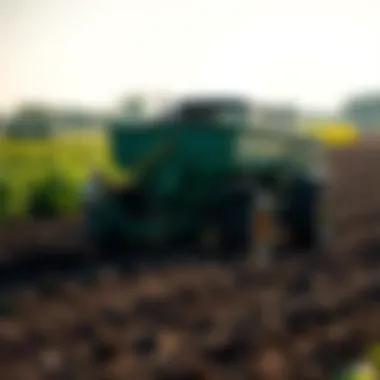

When it comes to keeping PTO manure spreaders running smoothly, knowing how to address repairs and when to replace parts is vital. Farmers should keep a well-stocked toolbox that includes commonly needed spare parts, but understanding more complex repairs can also be crucial.
- Know the Parts: Familiarize yourself with the main components of your PTO spreader. This includes the transmission, bearings, and various belts and chains. Knowing which parts are most susceptible to wear will help in prioritizing inspections.
- Keep it Clean: After each use, clean the spreader thoroughly. Manure is corrosive, and debris can jam moving parts, leading to more significant issues down the line.
- Professional Help: For parts that require more technical skills to fix, don’t hesitate to consult a professional. Sometimes, it’s cheaper in the long run to have an expert handle repairs, particularly when it involves electrical or hydraulic systems.
Replacing or repairing parts should not wait until there’s a breakdown. Instead, make it a part of the routine maintenance process. A machine that is well-cared for works efficiently, contributing to sustainability in agriculture.
Proper care of your PTO manure spreader can lead to increased productivity, soil health, and ultimately, better yields on your farm.
For more detailed insights, you may check resources like Wikipedia, Britannica, and forums such as Reddit for discussions on best practices and experiences among fellow agri-enthusiasts.
Environmental Impacts of Manure Spreading
Understanding the environmental impacts of manure spreading is essential for ensuring sustainable agricultural practices. As farmers strive to maintain their land's productivity while minimizing ecological harm, it becomes imperative to grasp how the application of manure influences both soil health and local ecosystems. Here, we explore two significant aspects: reducing nutrient runoff and contributions to soil microbiome health.
Reducing Nutrient Runoff
When manure is applied to fields, one of the major concerns is nutrient runoff. Phosphorus and nitrogen from manure can wash into nearby water bodies during rains. This runoff can lead to nutrient pollution, causing issues like algal blooms in lakes and rivers, which, in turn, deplete oxygen and harm aquatic life.
To mitigate this, farmers can adopt several best practices such as:
- Time the Application Well: Spreading manure before heavy rainfall can be detrimental. Instead, apply it during drier seasons or weather to reduce runoff risk.
- Buffer Strips: Establish vegetative buffer strips near water bodies to absorb excess nutrients before they reach the water.
- Soil Testing: Conduct soil tests regularly to determine nutrient needs so that you can apply just the right amount of manure without overloading.
Not only do these practices help in reducing nutrient runoff, but they also promote the health of surrounding environments. Better management leads to a sustainable approach, ensuring your farming practices align with ecological stewardship.
Contributions to Soil Microbiome Health
Manure spreading does more than just fertilize plants; it plays a critical role in enhancing the soil's microbial community, contributing to overall soil health. These microorganisms perform key functions, like breaking down organic matter and fixing nitrogen, which directly supports plant growth.
Incorporating manure can lead to:
- Increased Microbial Diversity: The organic matter in manure fosters a diverse range of soil microbial life. This diversity is crucial for nutrient cycling, helping plants access the required nutrients effectively.
- Soil Structure Improvement: Healthy soil microbiomes contribute to stronger soil structure, improving aeration and water retention. This means crops can tap into more nutrients and moisture, leading to better yields.
- Biological Pest Control: A thriving microbiome can inhibit plant pathogens, adding an additional layer of protection for crops.
In summary, responsible manure spreading contributes to a balanced ecosystem. It not only helps reduce nutrient runoff but also bolsters soil microbiome health, creating a vibrant environment for plants and organisms alike.
"Sustainable practices today ensure the agriculture of tomorrow remains productive and environmentally sound."
For more detailed guide on best practices and research, refer to USDA.gov and the Environmental Protection Agency for resources on sustainable manure management.
Future Innovations in Manure Spreading Technology
In the ever-evolving field of agriculture, manure spreading technology is not left behind. Innovations are paramount to enhance efficiency and sustainability. With increasing environmental concerns and the necessity for optimal nutrient management, understanding the future of these technologies is crucial for farmers looking to improve their operations while being mindful of ecological impacts. The focus here is on precision, efficiency, and minimizing waste, all of which will shape how manure is applied in the future.
Smart Application Systems
Smart application systems represent a significant leap forward. These systems leverage technology to optimize the distribution of manure based on real-time data. By utilizing sensors and GPS technology, these systems can make precise adjustments during application, ensuring that nutrients are applied where they are needed most. Here’s why this approach stands out:
- Decision Making: Smart systems can analyze soil health, moisture levels, and crop requirements. This analysis aids farmers in making informed decisions about when and where to spread manure.
- Resource Management: By applying the right amount at the right time, these systems help prevent over-application, which can lead to nutrient runoff and waterway pollution.
- Cost Efficiency: Reduced resource waste translates into savings. Fewer resources wasted means more funds left in the pocket for other operational necessities.
Implementing smart application systems can lead to a more sustainable, environmentally-friendly approach to manure spreading, pushing the boundaries of what farmers can achieve.
"Smart technology in agriculture not only promotes efficiency but also aligns with the broader goal of sustainability in farming practices."
Integration with IoT for Precision Farming
Integrating Internet of Things (IoT) technology into farming practices is transforming traditional methods, manure spreading included. This integration allows for connected devices to communicate and share key data, enhancing operational performance. Here’s how:
- Real-Time Monitoring: IoT devices can constantly monitor field conditions, such as soil moisture and temperature. This data feeds into decision-making systems for timely manure application, ensuring optimal growth conditions for crops.
- Automation: Automation processes can be introduced through IoT, streamlining operations. Automated systems can manage spreading without requiring constant farmer oversight, allowing for more efficient time management.
- Data-Driven Insights: The continuous flow of data can reveal trends over time, enabling farmers to tailor their manure spreading practices based on years of collected information, leading to improved crop yields and soil health.
Incorporating IoT into manure spreading offers farmers a sophisticated approach. As technology advances, the potential for more accurate and efficient manure spreading becomes a reality.
Closure
The discussion surrounding PTO manure spreaders encapsulates a vital segment of modern agriculture, emphasizing both functionality and sustainability. These machines play a significant role in nutrient management, enabling farmers to harness the full potential of manure as a fertilizer while ensuring responsible application to minimize environmental impact. By understanding the intricacies of PTO manure spreaders, farmers can transition to techniques that enhance productivity without neglecting ecological balance.
Summary of Key Points
Throughout this exploration, we’ve highlighted several essential components regarding PTO manure spreaders, including:
- Definition and Purpose: PTO manure spreaders are devices that utilize a tractor’s power output to evenly distribute manure across farmland, fostering optimal nutrient absorption by crops.
- Types of Spreaders: Different models such as rotary, chain floor, and vertical tillage spreaders offer varying approaches to manure application, each suited for distinct farming needs.
- Benefits: Efficient manure application boosts soil health, minimizes nutrient runoff, and significantly elevates crop yields.
- Best Practices and Maintenance: Proper usage timing, calibration, and regular inspections ensure these machines operate at peak efficiency, maintaining the health of both equipment and soil.
- Future Innovations: Smart application systems integrated with IoT technology promise even more precise control over manure spreading, revolutionizing fertilization strategies.
Final Thoughts on Adoption
Adopting PTO manure spreaders presents farmers with a dual opportunity: to enhance productivity while contributing to sustainable agricultural practices. As the agricultural landscape evolves, embracing new technologies and methodologies can make all the difference. It is imperative that farmers not only grasp the functionality and benefits of these spreaders, but also commit to ongoing education and adaptability in their use.
"The future of agriculture lies in our ability to embrace technology and adapt, while being stewards of the environment."
For further insights into this integral aspect of agricultural productivity, consider visiting resources such as Wikipedia, Britannica, or agriculture-related groups on Reddit. These platforms offer valuable discussions and updates on best practices in farming.



